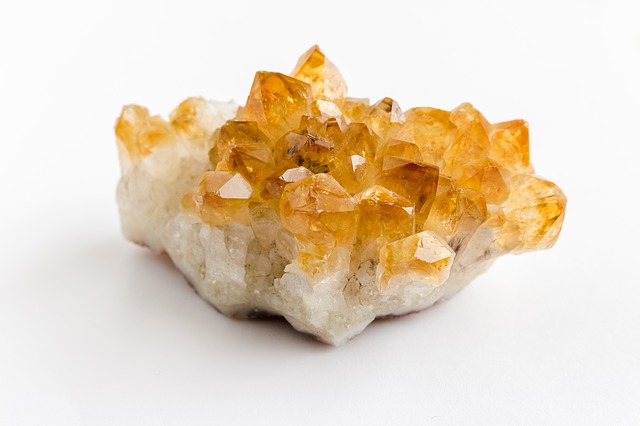
With its beautiful sunny glow, citrine has been long believed to be a treasured gift from the sun. As a variety of quartz minerals, citrine gets its name from the French word ‘citron,’ which means ‘lemon.’ With colors ranging from lemon yellow to a rich honey gold, citrine can light up any piece of jewelry due to its warm sunny shade. The stone is more affordable than most gems because it is available in abundance like all other quartz gems.
History of Citrine
Citrine was one of the most popular gems back in the 1940s. Its bright color and dramatic proportions led this gem to become one of the boldest stones of the era. Citrine was often set with aquamarines and rubies in colorful jewelry pieces, including necklaces, brooches, and bracelets.
What Does Citrine Symbolize?
Due to its bright color that emanates a beautiful golden glow, citrine is believed to symbolize optimism. In ancient times, however, this gem was believed to possess the power to protect one against evil words and thoughts.
Where is Citrine Found?
Most citrines available on the market have been mined in Brazil. Bolivia is another country that has become a leading producer of the gem. In fact, Bolivia also produces a gem known as ametrine, which is the unique combination of amethyst and citrine. Additionally, citrine is also found in Namibia, Zambia, and Tanzania.
Citrine very rarely occurs naturally. Most citrines start out as amethysts and are then heat-treated to become yellow or yellowish-brown. So, if you do get your hands on a citrine, it’s best to assume that it has been heat-treated.
Before modern gemology, citrine was often confused with topaz. In fact, many people still refer to citrine as topaz quartz. The truth is that topaz is a completely different mineral that is not to be confused with citrine.
How to Buy Citrine
As with any mineral, there are the 4 C’s guidelines you need to consider when buying citrine.
Color
Although citrine is generally thought to be a yellow gemstone, its colors can range from a light lemony hue to an earthy brown shade. Even though everyone has their own preference when it comes to color, it is important to see for saturated colors with an even tone across the stone. The most valuable citrine is the one with a saturated golden hue with fiery orange flashes.
Clarity
As with all colored gemstones, the same rule applies to citrine: the clearer, the better. Inclusions and blemishes can considerably degrade the value of a gemstone. Due to the fairly light color of citrine, you will often come across stones with very visible inclusions. However, since citrine is found in huge quantities, you don’t need to compromise on the clarity and quality of the gem. When buying citrine, make sure to search for eye-clean gemstones that have no prominent inclusions, cracks, or blemishes.
Carat
With citrine being available abundantly, you can find them in some enormous sizes. Citrine is often readily available in huge carat sizes that can be used in eye-catching pendants or chunky earrings or rings. The best part about this gem is that you can buy even a 10 or 20-carat gem at a very reasonable price.
Cut
Citrine is a fairly durable gem that can easily be cut in the most stunning shapes. Besides the basic cuts, this gem can also include some fancy carvings, cabochons, and even flower cuts. It is quite important to pay attention to the quality of the cut, as it is what ultimately determines the beauty of the gem. A well-cut citrine will emanate a brilliant sparkle evenly across the entire gem.
How to Care for Citrine
Citrine is a fairly durable gem but isn’t as strong and durable as you’d want it to be. The facets of citrine slowly wear down over time due to the dust in the air. Although citrine has a stable color, exposure to high heat may end up deteriorating the color over time. Additionally, if you’re wearing a citrine ring, you will have to wear it very carefully since it can be prone to chipping.
The best way to clean citrine is with mild dish soap and water. It is also recommended to take off your jewelry when applying creams or lotions. Moreover, make sure to store all your gems separately to keep them from scratching each other.
Citrine vs. Yellow Sapphire
When it comes to appearance, yellow sapphire is the only yellow gem that comes closest to citrine. However, these gems differ in many other ways. For instance, while a yellow sapphire has a hardness rating of 9, citrine has a hardness rating of 7, deeming it fairly weaker than sapphires. Also, citrines are found in abundance, which is reflected by their affordable prices. Sapphires, on the other hand, are rarer and much more expensive.
Citrine for Engagement Rings
Although diamonds and sapphires are the most popular gemstone choices for engagement rings, don’t underestimate the power and beauty of citrine. With a rating of 7 on the Mohs scale, citrines are fairly hard and durable stones that can be used for engagement rings. The most popular engagement ring style is a halo ring with a pave band. Other options include large citrine solitaires and three-stone citrine rings that feature a stunning round or emerald-cut citrine stone in the center with two diamonds on either side. The beautiful shades of yellow also allow citrines to go well with different metals, including yellow gold, white gold, and rose gold.
The Bottom Line – Why We Love Citrine
Citrine is the alternative birthstone for the month of November. Found in various styles, shapes, and some stunning colors, citrine is certainly a treasured stone. This gem is loved by many mainly due to its warm color, lovely shades of golden, and affordability. Whether you’re looking to incorporate a beautiful yellow gem in your necklace, bracelet, or engagement ring, citrine should be your top choice.
